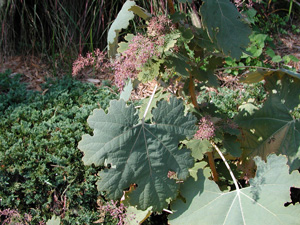Resource Library
Plant of the Week: Poppy, Plume
The University of Arkansas System Division of Agriculture does not promote, support or recommend plants featured in "Plant of the Week." Please consult your local Extension office for plants suitable for your region.
Plant of the Week
Plume Poppy
Latin: Macleaya cordata

I for one am tired of wimpy plants, but I don’t like bullies and thugs much either. Like Goldilocks’ porridge, I want my plants somewhere in between the extremes. Plume poppy (Macleaya cordata) I think of as a Fonz-like character, acting tougher than it really is.
Plume poppy is a 6- to 8-foot tall herbaceous perennial of the poppy family that is one of two species native to China and Japan. It spreads by underground rhizomes and established clumps produce several erect, yellow-sapped hollow stems that bear alternate, almost round, dinner plate sized leaves with interesting scalloped leaf margins. The upper leaf surface is a light olive green while the undersurface is grayish. The leaves are reminiscent of our native bloodroot but they persist throughout the growing season instead of being spring ephemerals like this small creeping wildflower.
In late spring, 16-inch long airy, terminal panicles of blooms are produced at the ends of the stems. The small individual flowers lack true petals but have a pair of quarter-inch long deciduous sepals supporting a mass of 24 to 30 showy stamens. Up close, the flowers don’t look like much, but the mass of the inflorescence is attractive, especially when viewed from afar. As seed pods begin to form the inflorescence takes on a reddish cast.
Until the early part of the 20th century the plant was included in the genus Bocconia, a group of woody members of the poppy family. Finally the two herbaceous species were separated and returned to the genus Macleaya which honors Alexander Macleay (1767 – 1848) who served as honorary secretary of the Linnean Society in London.
This species was introduced into Europe in the late part of the 18th century and gained some use in large estate gardens at that time, but did not gain much traction in garden usage until the height of the Victorian bedding out period during the latter half of the 19th century. Its bold and extravagant form fit well with other Victorian favorites such as castor bean, showy cannas, giant reed grass and cut-back plantings of big-leafed trees such as catalpa, tree of heaven and Paulownia. It seems to have been introduced into the U.S. during this period, and though shown as naturalized in most of the eastern states today, it seems to be rarely encountered in the wild.
In the new plant revival of recent years, plume poppy has staged a comeback of sorts but it is still only infrequently met with in gardens. Plume poppy does spread aggressively by underground rhizomes but it is not difficult to keep in place by once or twice yearly excursions to pull up unwanted suckers. Plants will reseed if panicles are not removed before seeds mature. The seedlings I have observed around plants here in Northwest Arkansas have been in disturbed places that are kept well watered, and then only a few seedlings have emerged. This plant should not be planted if some provision is not made to help control its wandering ways.
This bold perennial is hardy from zones 4 through 10 and is well-adapted to a wide array of soil types but does best in a fertile, moist yet well-drained sites. Good soils only encourage its rampant ways. It will grow in full sun or light shade. In hot areas, it is best planted where it gets some afternoon shade or the foliage will be tattered and burned by late summer. It combines well with trees such as redbud, smoketree and dogwood and large shrubs where the bold foliage finds a comfortable coexistence with its green neighbors. The competition also helps keep the plant in check.
By: Gerald Klingaman, retired
Retired Extension Horticulturist - Ornamentals
Extension News - June 29, 2012
The University of Arkansas System Division of Agriculture does not maintain lists of retail outlets where these plants can be purchased. Please check your local nursery or other retail outlets to ask about the availability of these plants for your growing area.